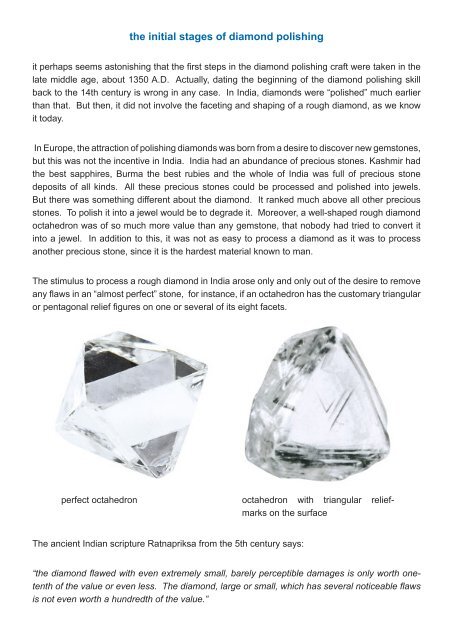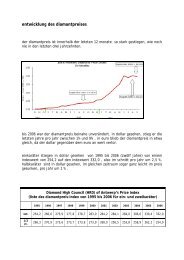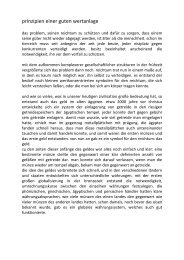The diamond in ancient India - Diamantschleiferei Michael Bonke
The diamond in ancient India - Diamantschleiferei Michael Bonke
The diamond in ancient India - Diamantschleiferei Michael Bonke
- No tags were found...
You also want an ePaper? Increase the reach of your titles
YUMPU automatically turns print PDFs into web optimized ePapers that Google loves.
the <strong>in</strong>itial stages of <strong>diamond</strong> polish<strong>in</strong>git perhaps seems astonish<strong>in</strong>g that the first steps <strong>in</strong> the <strong>diamond</strong> polish<strong>in</strong>g craft were taken <strong>in</strong> thelate middle age, about 1350 A.D. Actually, dat<strong>in</strong>g the beg<strong>in</strong>n<strong>in</strong>g of the <strong>diamond</strong> polish<strong>in</strong>g skillback to the 14th century is wrong <strong>in</strong> any case. In <strong>India</strong>, <strong>diamond</strong>s were “polished” much earlierthan that. But then, it did not <strong>in</strong>volve the facet<strong>in</strong>g and shap<strong>in</strong>g of a rough <strong>diamond</strong>, as we knowit today.In Europe, the attraction of polish<strong>in</strong>g <strong>diamond</strong>s was born from a desire to discover new gemstones,but this was not the <strong>in</strong>centive <strong>in</strong> <strong>India</strong>. <strong>India</strong> had an abundance of precious stones. Kashmir hadthe best sapphires, Burma the best rubies and the whole of <strong>India</strong> was full of precious stonedeposits of all k<strong>in</strong>ds. All these precious stones could be processed and polished <strong>in</strong>to jewels.But there was someth<strong>in</strong>g different about the <strong>diamond</strong>. It ranked much above all other preciousstones. To polish it <strong>in</strong>to a jewel would be to degrade it. Moreover, a well-shaped rough <strong>diamond</strong>octahedron was of so much more value than any gemstone, that nobody had tried to convert it<strong>in</strong>to a jewel. In addition to this, it was not as easy to process a <strong>diamond</strong> as it was to processanother precious stone, s<strong>in</strong>ce it is the hardest material known to man.<strong>The</strong> stimulus to process a rough <strong>diamond</strong> <strong>in</strong> <strong>India</strong> arose only and only out of the desire to removeany flaws <strong>in</strong> an “almost perfect” stone, for <strong>in</strong>stance, if an octahedron has the customary triangularor pentagonal relief figures on one or several of its eight facets.perfect octahedron octahedron with triangular reliefmarkson the surface<strong>The</strong> <strong>ancient</strong> <strong>India</strong>n scripture Ratnapriksa from the 5th century says:“the <strong>diamond</strong> flawed with even extremely small, barely perceptible damages is only worth onetenthof the value or even less. <strong>The</strong> <strong>diamond</strong>, large or small, which has several noticeable flawsis not even worth a hundredth of the value.”









